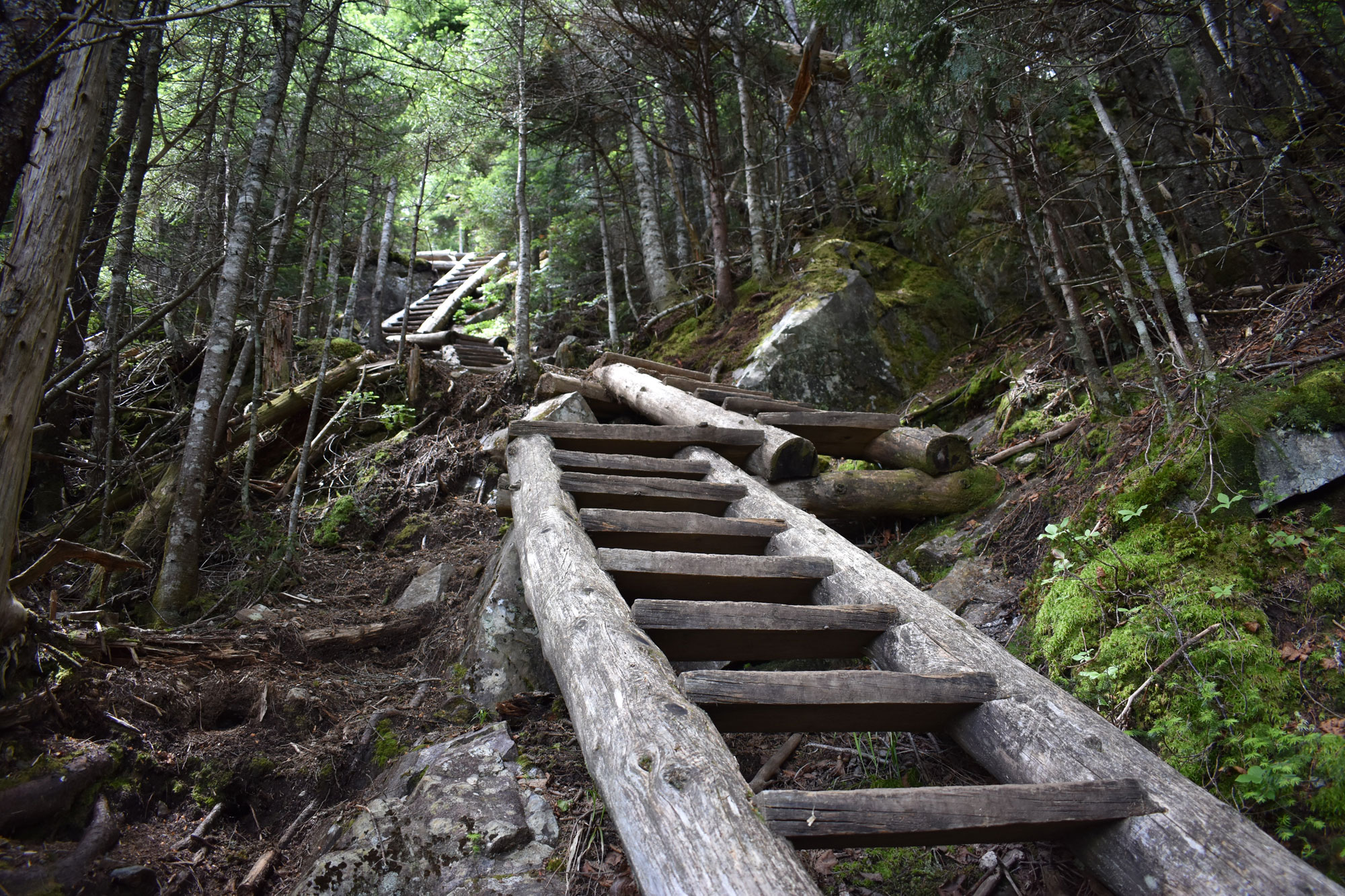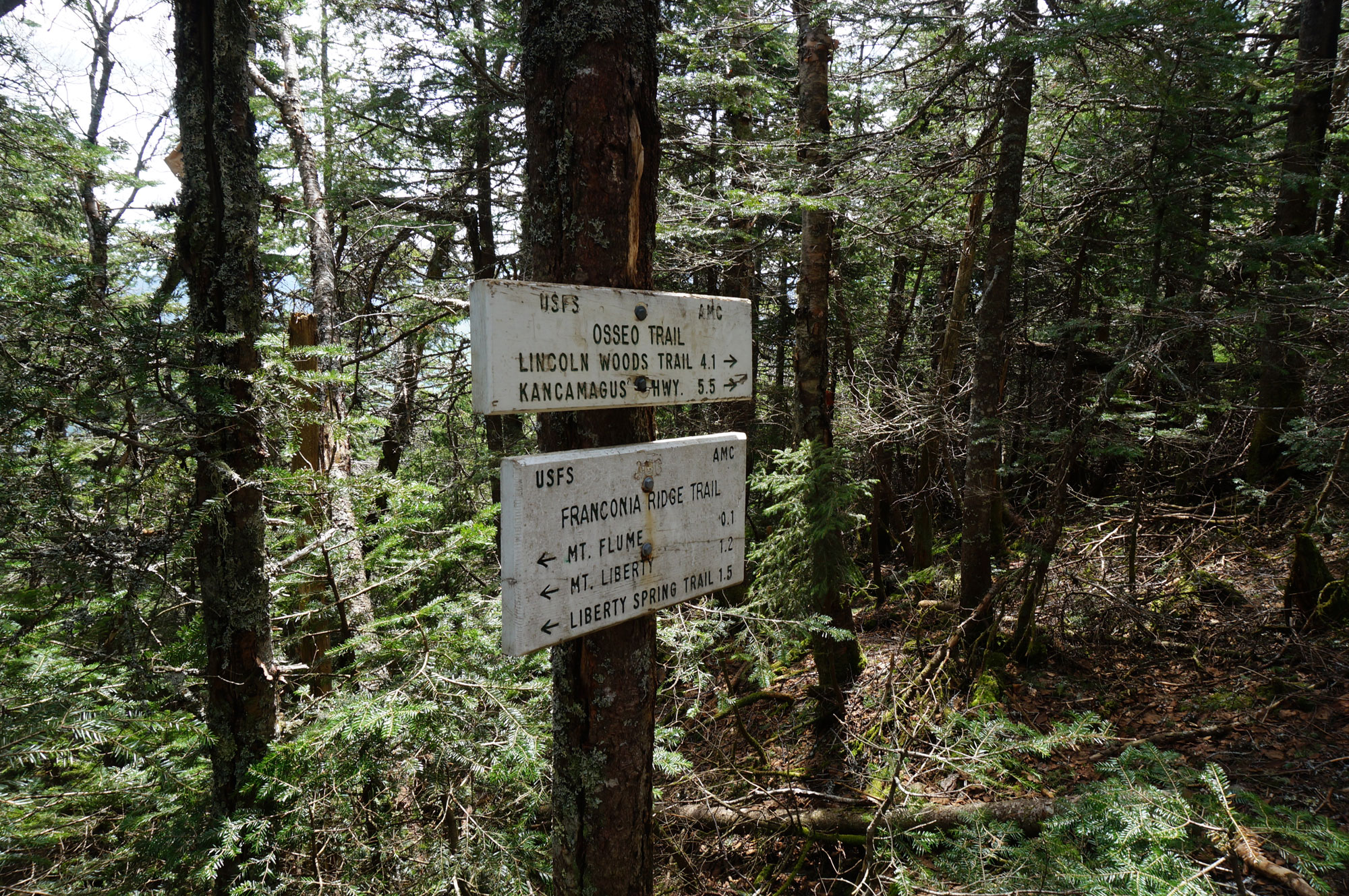New Hampshire’s mountains have a reputation for historic trails, rugged peaks, and unpredictable weather. They’re also known for their lists—from the New Hampshire 48 to the 52 With a View, hikers consistently find ways to challenge themselves and visit new areas in the Granite State. One list that continues to capture the imaginations of audacious hikers is the Terrifying 25, a collection of challenging trails that include everything from slides and stairs to crawling through caves.

The History of the Terrifying 25
The popularity of the Terrifying 25 makes it hard to believe that it’s a relative newcomer to New Hampshire lists, created less than a decade ago. Compare that to other lists like the NH 48, which has its origins in the 1950s, and 52 WaV, which dates back to the early 1990s.
The minds behind this collection of nerve-wracking routes are Trish Herr and her daughters, Alex and Sage. Together they’ve logged a lot of miles in the White Mountains over the years—Alex finished her first round of New Hampshire 4,000-footers by age six and all three finished the grid (summiting each of the 48 4,000-footers in every calendar month) this past June.
The Terrifying 25 was created by the Herrs simply for their amusement and was born from their enjoyment of trails featuring scrambles and caves.

What’s Unique About the Terrifying 25
One thing that sets the Terrifying 25 apart from other lists is that it’s actually a combination of two lists—one list of 20 required trails and another of 14 elective trails. To complete the Terrifying 25, you must complete all 20 trails on the required list plus five trails from the elective list. This provides hikers the chance to customize their list for any number of reasons, from geography to personal trail preference—seeking out features like ladders, scrambling, or rock hopping.
The reason for the two lists is consensus. The 20 required trails are generally agreed upon as tricky, scrambly, and/or just plain fun. But for the 14 elective trails, there is less unanimity over their challenge—some may find them difficult while others will think they’re tame.
Another way that the Terrifying 25 distinguishes itself from New England’s other lists is that there’s no winter patch (i.e., special recognition of completing the trails in winter), nor do they acknowledge the achievement of dogs. This is because technical climbing ability is needed to ascend some of the trails in winter conditions and the nature of the trails make them unsuitable for many dogs.

The Terrifying 25 Trails
The Terrifying 25 Required Trails
- Baldface Circle Trail
- Caps Ridge Trail
- Carter Ledge Trail
- Castle Trail
- Chemin Des Dames
- Flume Slide Trail
- Great Gulf Trail
- Great Gully Trail
- Huntington Ravine Trail
- Ice Gulch Path
- King Ravine Trail
- Madison Gulf Trail
- Mount Morgan Trail (ladder route)
- Mount Percival Trail (cave route)
- North Slide on North Tripyramid
- Six Husband’s Trail
- South Slide on South Tripyramid
- Sphinx Trail
- Subway (King Ravine Trail)
- Table Rock Trail (from Eastern trailhead to ledge)
The Terrifying 25 Elective Trails
- Airline Trail
- Algonquin Trail
- Beaver Brook Trail
- Brook Trail
- Blueberry Ledge Trail
- Castle Ravine Trail
- Desolation Trail
- Devil’s Hopyard
- Goodrich Rock Trail
- Hi-Cannon Trail
- Osseo Trail
- Percy Peaks Trail
- Wildcat Ridge Trail (from Route 16 to E Peak)
- Willey Range Trail (ladder section to summit)

The Rules of the Terrifying 25
The rules of the Terrifying 25 are wonderfully simple. To qualify for a patch, you must:
- Hike the entire length of the 20 required and 5 elective trails under your own power; and
- Hike them in either direction (although many will find them easier to ascend than descend).
It doesn’t matter how you get to the trailhead—for example, you could ride a bike along the Lincoln Woods Trail to the beginning of the Osseo Trail, rather than hiking the first roughly 1.5 on the Lincoln Woods Trail. Also, keep in mind that you’re hiking at your own risk, these trails are demanding and in some cases dangerous.

Tips for Completing the Terrifying 25
The best preparation for tackling the Terrifying 25 is to get your boots on the ground and rack up mileage in the White Mountains. Many turn to the Terrifying 25 after completing other popular lists like the NH 48 and 52 WaV, and many of the trails on the Terrifying 25 lead to the summits of these peaks. While experience is your best ally on the Terrifying 25, here are some additional things to think about when tackling the list.
Beta: Before heading out on any of the Terrifying 25 trails, make sure you know what you’re in for—for example, steep slab, loose scrambling, or tight caves—and understand whether or not it’s in your comfort zone. The AMC’s White Mountain Guide is a great place to start this research.
Conditions: The only thing scarier than hiking a trail like the Huntington Ravine Trail is hiking it when it’s wet or icy. Do some research and try to get an up-to-date report on trail conditions.
Weather: Similarly, know the weather before tackling a Terrifying 25 trail. As mentioned, wet weather will make many of them extra challenging, and routes like the Caps Ridge Trail or Airline are the last place you want to find yourself in lightning. Read the Mount Washington Observatory’s daily higher summits forecast before you head out.
Be willing to turn around: These trails aren’t going anywhere, so if you find that you aren’t up to the challenge or a trail isn’t in the right condition, turn around—you can always come back.
Build up: There’s a big difference in mileage and elevation between the easiest and most challenging trails on the Terrifying 25. For example, a loop of Mount Morgan and Percival offers about 5 miles and 1,500 feet of elevation, while the Great Gulf Trail climbs more than 4,500 feet in its roughly 7.5 miles. A sound strategy is to start small and build up as you go.
Consider a different descent: Many of the trails on the Terrifying 25 are significantly easier to hike up than down—the Huntington Ravine Trail and Wildcat Ridge Trail are two good examples of this.
Link trails: Some trails are tricky to descend, but others are easily linked together, although they might require a second car. Flume Slide Trail and the Osseo Trail, the Mount Morgan Trail (ladder route) and the Mount Percival Trail (cave route), and North Slide on North Tripyramid and the South Slide on South Tripyramid are three pairs that are easily combined.
Have you tackled any of New Hampshire’s Terrifying 25 Trails? If so, we want to hear about it! Let us know about your adventure in the comments below.
Tim Peck and Doug Martland
Tim and Doug met long ago at the Eastern Mountain Sports in Canton, Massachusetts. Bonding over a love of slick Quincy Quarry granite, White Mountain sufferfests, and scheming up adventures while folding tee-shirts, today Tim and Doug collaborate to write about their favorite outdoor activities and occasionally get nostalgic about tee-shirt tables.
Related Posts
April 12, 2024
Explore Like a Local: The Outdoor Mecca of North Conway, NH
There's a lot to love about this New…
April 3, 2024
5 Things To Do in the Boston Area During Mud Season
Adventure opportunities are abundant…




